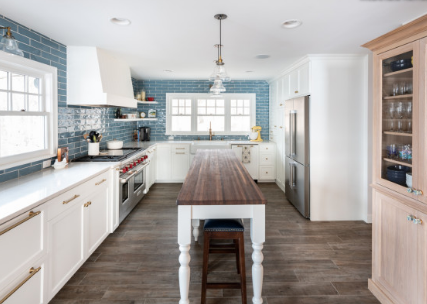There are many reasons to add an island to your kitchen – such as extra storage space, seating, and workspace. But there are also several reasons why you might want to choose one island shape and style over another. This guide covers six popular kitchen island styles that will help you decide which one is right for you.

1. L-Shaped
This type of island can rise and fall with the shape of the kitchen, or fill a blank space with more storage and prep space.
Pros:L-shaped islands tend to be larger and have correspondingly ample storage space. Their bulky design ensures that the workspace is not crowded, which is a huge perk for families with enthusiastic chefs or more than one chef. Finding space for bar-style seating won’t be a problem. If you’re not a fan of clean lines, the L-shaped island brings some appeal.
Cons: While L-shaped islands may be larger and offer more space for preparation, they are not exactly an open concept. They can ruin your kitchen design, which can affect the efficiency of meal preparation. For some homeowners, the shape can be too spread out, and it doesn’t always maximize storage space, as corners tend to reduce accessibility.

2. Galley Kitchen
The kitchen island has less decoration and a simple design, which is built for the workhorse. They are perfect for any type of kitchen layout, provided there is enough space.
Pros: Kitchen islands are often considered the typical island design for an open kitchen, with a streamlined design that ensures your space flows and stays productive. They usually maximize storage space because there aren’t any corners or curves. Appliances and stored items are always available. The design also leans towards bar-style seating.
Cons: Yes, kitchen islands are simple and efficient, but some homeowners may find them boring. They’re certainly not going to be amazing, unless they’re larger than a real person or have a complex appearance. Sometimes they are too small to comfortably accommodate the device, which can cause problems for your layout.

3. Circular or Curved
If you want to add personality to your kitchen layout, a round island might be for you. The design can be a full circle or a half-moon.
Pros: The round and curved island adds interesting visual dynamics to the kitchen. If you don’t want a plain island design, they are the first choice. Just like the L-shaped islands, they are full of preparation space. There is plenty of space to operate while preparing meals. The circular design can accommodate a spacious seating area, leaving enough space for more than four guests to eat and socialize comfortably.
Cons: The preparation and storage space of round islands is not always effective. Your counters are scattered and curved, which limits how you can cook. In some designs, storage units may be more difficult to access (for example, they may be located under countertop overhangs). Unless your cabinets are customized to include creative options, plan for wasted storage space.

4. Furniture Style
A furniture island is an unconventional option that can make your kitchen feel like the premier gathering place in your home. A variety of options include custom-made pieces designed by local carpenters and antique tables or chests of drawers.
Pros: Whether it’s custom-made, an old heirloom, or store-bought furniture, it can add character to your kitchen. It’s a way to inject a personal touch into your space and make it your own. The details and decoration of the furniture will catch the eye of the guests. These parts are usually not bulky and can fit seamlessly into your kitchen. An open design can create a beautiful display for your décor.
Cons: Furniture isn’t always used for storage, so the antiques you must have may not fit most of your cookware. There is also the issue of durability. Old pieces may not last long in the hustle and bustle of a modern kitchen. Wear and tear can take a toll. The top of the furniture cannot withstand impacts like granite or quartz.

5. U-Shaped
The U-shaped island could be a chef’s dream. Three walls of cabinetry and appliances are enough to increase the efficiency of any kitchen.
Pros:The U-shaped island is both functional and spacious, and is probably the largest and most inclusive. Extra storage? View. More workspace? You’re right. Can I sit in the room? There are even such. If they are large enough, they can hold more than one device. You may not have to leave the island when you are preparing your food.
Cons: Its huge size is also probably the biggest disadvantage of the U-shaped island. Some homeowners may find cooking and cleaning less efficient and may hate the distance from side to side. These islands are bulky and may separate your kitchen from the rest of your home. Double corners sacrifice accessible storage space unless they have a Lazy Susan or swing out unit.

6. Rolling
Don’t have room for an island? No problem. Rolling islands is a convenient option. You can stir them while you’re lounging around the kitchen and then tuck them neatly to the side when you’re done cooking.
Pros: The rolling island is the best of the versatile. For small kitchens that lack enough space to prepare, they are a godsend and can be used as worktops, food trays, or spare countertops for placing ingredients. Depending on the size, they are easy to store and move. On top of that, they are very affordable compared to cabinets.
Cons: Not everyone can cook on wheels. Rolling islands are compact and simply not suitable for some homeowners, even those who are short on space. When it comes to dining or storage, rolling islands can be a hassle. For some homeowners, larger designs can be difficult to move. They offer little to no storage space.


